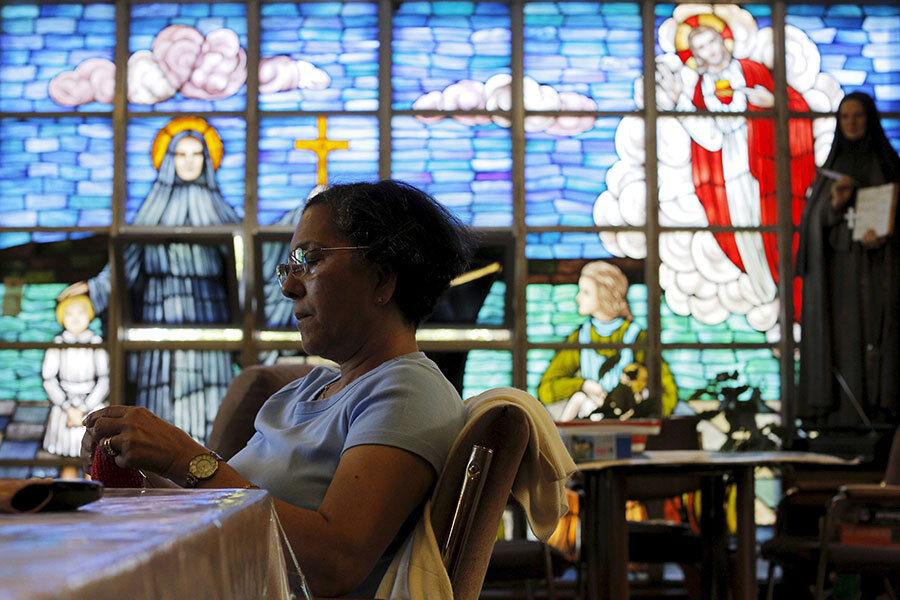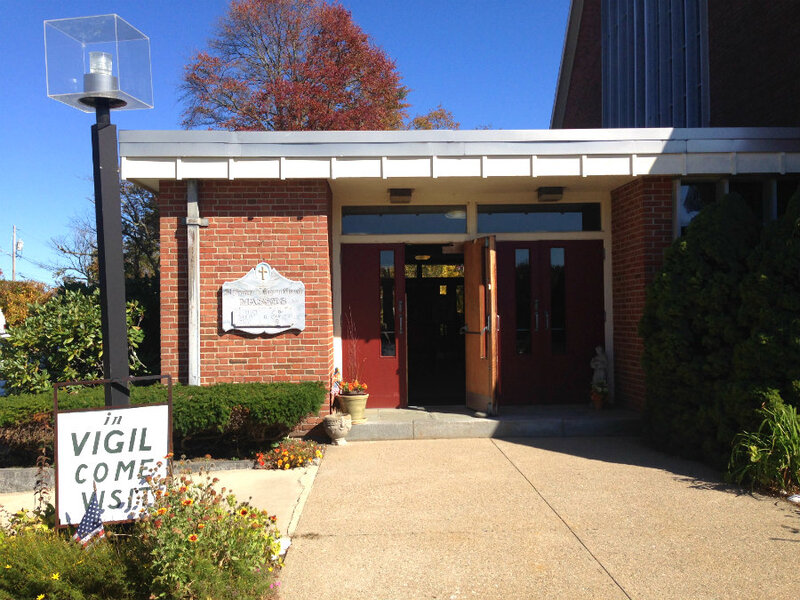In Massachusetts, an 11-year vigil to redefine church
Loading...
| SCITUATE, Mass.
Nearly every Sunday for the past 11 years, 90-something Evelyn Morton and her daughter have made the 12-mile drive from their home in East Weymouth, Mass., to the church of St. Frances Xavier Cabrini in Scituate.
There, from about two to four o’clock in the afternoon, they held vigil with local parishioners, fighting to keep the church open after the Roman Catholic Archdiocese of Boston closed the building in 2004.
On Thursday – the day after Massachusetts’ top court ruled that the parishioners were trespassing by occupying the church – Ms. Morton made the drive herself.
“Our church was closed, too,” she says, her curly white hair bobbing as she speaks. The Archdiocese later reversed its decision and reopened her church, St. Albert the Great. “We all have to stick together,” Morton says.
St. Frances X. Cabrini is the last holdout of six churches occupied in protest after the Archdiocese attempted to reconfigure local parishes following a clergy sex abuse scandal more than a decade ago. The case aggravated a problem already facing Catholic churches across the nation: declining attendance and donations and too few priests.
But the case also highlights a deeper problem for churches particularly in the Northeast, but also across the country. As the number of churchgoers declines, St. Frances X. Cabrini points to the question of what church is in the hearts of its parishioners and priests.
“The standoff indicates … how differently a certain number of American Catholic laity perceive what it means to be a church, compared to what the hierarchy or clerics mean to be a church,” says Bruce Morrill, the Edward A. Malloy Chair of Catholic Studies at Vanderbilt University in Nashville, Tenn. “The way [the laity] articulate it is in terms of community, relationships, neighborly love. For the hierarchs, it’s at a more abstract level.”
Maryellen Rogers, who leads the protest effort at St. Frances with her husband, Jon, says the church is a symbol of history and community, priest or no priest.
“I’m a lifelong parishioner. This is my home,” she says. “I buried a brother here, a father. I got married here. It’s more than just a building. It’s a community.”
For the Catholic Church, the situation has been brought to a head by a shrinking priesthood. Between 1990 and 2014, the number of ordained priests in the United States dropped by more than a quarter, according to the latest figures from the Center for Applied Research in the Apostolate at Georgetown University in Washington. During the same period, about 10 percent of parishes in the US closed, and the number of parishes without a resident priest pastor nearly doubled.
The shrinking number of priests highlighted the rift between the Catholic hierarchy and many of the faithful. The Catholic Church defines a parish as a territory or collection of neighborhoods in the care of a priest or deacon appointed by the region’s bishop.
Yet in the absence of a priest, and without official sanction, parishioners across the US – including those at St. Frances – have started running their own churches, holding services led by lay ministers, and relying on visiting priests to consecrate the elements of the Eucharistic sacrament, or the Mass, says Nancy T. Ammerman, a professor of sociology of religion at Boston University’s School of Theology.
“They’re doing all the things a parish does,” but without a resident pastor, she says. “That way of operating as a parish is more akin to a Protestant congregation.”
Yet the issues go beyond the size of the Catholic priesthood – or even the Catholic Church. The fervor of the Scituate parishioners notwithstanding, weekly church attendance in New England is the lowest in the nation, according to a February Gallup poll. In Massachusetts, only 22 percent of residents report going to any kind of religious service.
“The people who have kept up this vigil for so long are to be commended for their faith and fidelity, and their responsibility as concerned Catholics,” writes Francis Clooney, a Jesuit priest and professor of divinity at the Harvard Divinity School, in an e-mail. “However, I have sympathy with the Archdiocese which, faced with financial difficulties and a diminishing number of priests … had to make decisions about which parishes could be maintained.”
“I am sure those charged with this task did not enjoy making the decision” to close the church, he adds.
On Wednesday, the Massachusetts Supreme Judicial Court upheld a previous lower-court decision that the parishioners, who call themselves the Friends of St. Frances Cabrini, are trespassing on property owned by the Archdiocese of Boston. The Archdiocese has since urged the parishioners to vacate the property.
“We appreciate the court having taken the time to review this matter and issue its ruling,” it said in a statement. “We ask the Friends of St. Frances to respect that decision and conclude the vigil.”
At the church on Thursday, the parishioners strove to present a strong front. Jon Rogers, dressed smartly in a gray suit and a tie, stayed on message as reporters crowded the building’s reception area. His wife, in a fuschia jacket and pearls, confirmed that at least one person has held vigil at the church every day since October 2004.
“Without people, this isn’t a church at all,” Mr. Rogers says. “If you look into the future – if the churches are going to survive – you’re going to need more that are modeled after this, where the people are the center.”
One of the parishioners, Nancy Shilts, showed to visitors the “resistance quilts” that a local woman had embroidered for every year of the vigil and which hung on walls between the church’s stained glass windows.
“It’s God’s house,” she says proudly. “People walk in from all over the world. They want to come in and see us.”
Small cracks in the group’s 11-year resolve were apparent: personal belongings packed away in a small room off the church nave and a mostly empty shelf, which Rogers says once held parishioners’ photos. “Some people have taken home personal items,” he says.
But even on a Thursday afternoon, when only the parishioners already retired could stay for the vigil, a sense of community and purpose pervaded both the place and the people – and none more so than Morton.
“I’m going to keep it up as long as I can,” she says, as she rested on a wooden chair beside a table laden with Dunkin’ Donuts pastries and coffee. “I’ll walk for anything I think is right, and I think we’re doing the right thing. We all have to stick together.”










